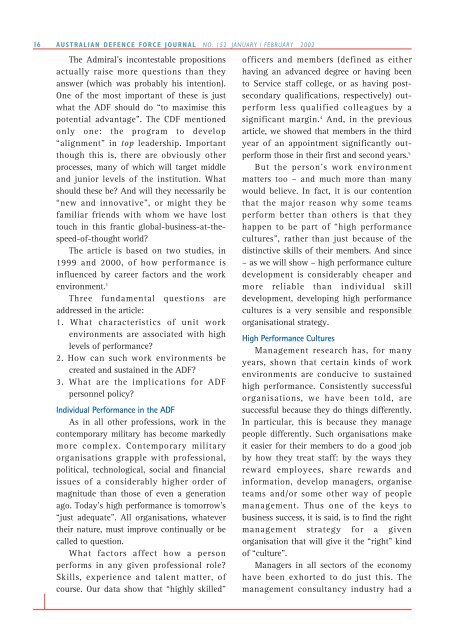ISSUE 152 : Jan/Feb - 2002 - Australian Defence Force Journal
ISSUE 152 : Jan/Feb - 2002 - Australian Defence Force Journal
ISSUE 152 : Jan/Feb - 2002 - Australian Defence Force Journal
- No tags were found...
Create successful ePaper yourself
Turn your PDF publications into a flip-book with our unique Google optimized e-Paper software.
16AUSTRALIAN DEFENCE FORCE JOURNAL NO. <strong>152</strong> JANUARY / FEBRUARY <strong>2002</strong>The Admiral’s incontestable propositionsactually raise more questions than theyanswer (which was probably his intention).One of the most important of these is justwhat the ADF should do “to maximise thispotential advantage”. The CDF mentionedonly one: the program to develop“alignment” in top leadership. Importantthough this is, there are obviously otherprocesses, many of which will target middleand junior levels of the institution. Whatshould these be? And will they necessarily be“new and innovative”, or might they befamiliar friends with whom we have losttouch in this frantic global-business-at-thespeed-of-thoughtworld?The article is based on two studies, in1999 and 2000, of how performance isinfluenced by career factors and the workenvironment. 3Three fundamental questions areaddressed in the article:1. What characteristics of unit workenvironments are associated with highlevels of performance?2. How can such work environments becreated and sustained in the ADF?3. What are the implications for ADFpersonnel policy?Individual Performance in the ADFAs in all other professions, work in thecontemporary military has become markedlymore complex. Contemporary militaryorganisations grapple with professional,political, technological, social and financialissues of a considerably higher order ofmagnitude than those of even a generationago. Today’s high performance is tomorrow’s“just adequate”. All organisations, whatevertheir nature, must improve continually or becalled to question.What factors affect how a personperforms in any given professional role?Skills, experience and talent matter, ofcourse. Our data show that “highly skilled”officers and members (defined as eitherhaving an advanced degree or having beento Service staff college, or as having postsecondaryqualifications, respectively) outperformless qualified colleagues by asignificant margin. 4 And, in the previousarticle, we showed that members in the thirdyear of an appointment significantly outperformthose in their first and second years. 5But the person’s work environmentmatters too – and much more than manywould believe. In fact, it is our contentionthat the major reason why some teamsperform better than others is that theyhappen to be part of “high performancecultures”, rather than just because of thedistinctive skills of their members. And since– as we will show – high performance culturedevelopment is considerably cheaper andmore reliable than individual skilldevelopment, developing high performancecultures is a very sensible and responsibleorganisational strategy.High Performance CulturesManagement research has, for manyyears, shown that certain kinds of workenvironments are conducive to sustainedhigh performance. Consistently successfulorganisations, we have been told, aresuccessful because they do things differently.In particular, this is because they managepeople differently. Such organisations makeit easier for their members to do a good jobby how they treat staff: by the ways theyreward employees, share rewards andinformation, develop managers, organiseteams and/or some other way of peoplemanagement. Thus one of the keys tobusiness success, it is said, is to find the rightmanagement strategy for a givenorganisation that will give it the “right” kindof “culture”.Managers in all sectors of the economyhave been exhorted to do just this. Themanagement consultancy industry had a
















